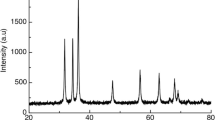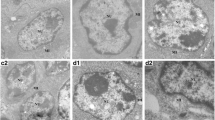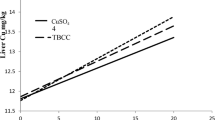Abstract
Manganese (Mn) is an essential trace element required for normal development and bodily function. However, little is known about the effect of excessive amounts of Mn in immune organs of poultry. The aim of this study was to investigate the effect of dietary Mn on the content of trace elements, such as copper (Cu), iron (Fe), zinc (Zn), calcium (Ca), and selenium (Se), and the mRNA level of IL-1β and IL-2 in immune organs (spleen, thymus, and bursa of Fabricius) and the content of IL-1β and IL-2 in serum of poultry. Fifty-day-old male Hyline cocks were fed either a commercial diet or a Mn-supplemented diet containing 600, 900, and 1,800 mg/kg. The immune organs were collected at 30, 60, and 90 days, respectively, and the content of trace elements and the mRNA level of IL-1β and IL-2 were examined; the serum were collected and the IL-1β and IL-2 contents detected. The results showed that Mn content in immune organs increased and Fe, Zn, and Ca contents decreased; however, Cu and Se contents showed no difference. IL-1β and IL-2 mRNA levels and IL-1β and IL-2 contents decreased. The present study demonstrates that excess exposure to Mn results in metal accumulations in immune organs. Manganism can disturb the balance of trace elements in immune organs and induce immune suppression in the molecular level; therefore, the immune function of cocks are also suppressed after manganism.






Similar content being viewed by others
References
Bourre JM (2006) Effects of nutrients (in food) on the structure and function of the nervous system: update on dietary requirements for brain. J Nutr Health Aging 10(5):377–385
Xu XR, Li HB, Wang WH et al (2005) Decolorization of dyes and textile waste water by potassium permanganate. Chemosphere 59(6):893–898
Park RM, Bowler RM, Roels HA (2009) Exposure–response relationship and risk assessment for cognitive deficits in early welding-induced manganism. J Occup Environ Med 51(10):1125–1136
Klos KJ, Ahlskog JE, Kumar N, Cambern S et al (2006) Brain metal concentrations in chronic liver failure patients with pallidal T1 MRI hyperintensity. Neurology 67(11):1984–1989
Iregren A (1999) Manganese neurotoxicity in industrial exposures: proof of effects, critical exposure level, and sensitive tests. Neurotoxicology 20(2–3):315–323
Bansal AK, Bilaspuri GS (2008) Effect of manganese on bovine sperm motility, viability, and lipid peroxidation in vitro. Anim Reprod 5:90–96
Zhang DH, Kanthasamy A, Anantharam V (2011) Effects of manganese on tyrosine hydroxylase (TH) activity and TH-phosphorylation in a dopaminergic neural cell line. Toxicol Appl Pharmacol 254(2):65–71
Misselitz B, Muhler A, Weinmann HJ (1995) A toxicological risk for using manganese complex? A literature survey of existing data through several medical specialties. Investig Radiol 30(10):611–620
Avila DS, Gubert P, Fachinetto R et al (2008) Involvement of striatal lipid peroxidation and inhibition of calcium influx into brain slices in neurobehavioral alterations in a rat model of short-term oral exposure to manganese. Neurotoxicology 29(6):1062–1068
Yin Z, Aschner JL, Santos AP, Aschner M (2008) Mitochondrial-dependent manganese neurotoxicity in rat primary astrocyte cultures. Brain Res 1203:1–11
Malecki EA (2001) Manganese toxicity is associated with mitochondrial dysfunction and DNA fragmentation in rat primary striatal neurons. Brain Res Bull 55(2):225–228
Wang X, Miller DS, Zheng W (2008) Intracellular localization and subsequent redistribution of metal transporters in a rat choroid plexus model following exposure to manganese or iron. Toxicol Appl Pharmacol 230(2):167–174
Milatovic D, Zaja-Milatovic S, Gupta RC et al (2009) Oxidative damage and neurodegeneration in manganese-induced neurotoxicity. Toxicol Appl Pharmacol 240(2):219–225
Rivera-Mancia S, Rios C, Montes S (2011) Manganese accumulation in the CNS and associated pathologies. Biometals 24:811–825. doi:10.1007/s10534-011-9454-1
Zwingmann C, Leibfritz D, Hazell AS (2004) Brain energy metabolism in a sub-acute rat model of manganese neurotoxicity: an ex vivo nuclear magnetic resonance study using [1–13C] glucose. Neurotoxicology 25(4):573–587
Sogut O, Percin F (2011) Trace elements in the kidney tissue of bluefin tuna (Thunnus thynnus L. 1758) in Turkish seas. Afr J Biotechnol 10(7):1252–1259
Harmanescu M, Popovici D, Gergen I (2008) Heavy metals contents for different honey samples from Berini Timis county. Proceeding of the International Conference Bioatlas, Transilvania University of Brasov, Romania
AL-Gahri MA, Almussali MS (2008) Microelement contents of locally produced and imported wheat grains in Yemen. ISSN: E-J Chem 5(4):838–843
Hasunuma R, Ogawa T, Kawanishi Y (1982) Fluorometric determination of selenium in nanogram amounts in biological materials using 2,3-diaminonaphthalene. Anal Biochem 126(2):242–245
Yu D, Li JL, Xu SW et al (2011) Effects of dietary selenium on selenoprotein W gene expression in the chicken immune organs. Biol Trace Elem Res 144:678–687. doi:10.1007/s12011-011-9062-5
Li JL, Gao R, Xu SW et al (2010) Testicular toxicity induced by dietary cadmium in cocks and ameliorative effect by selenium. Biometals 23:695–705
Sun B, Wang R, Xu SW (2011) Dietary selenium affects selenoprotein W gene expression in the liver of chicken. Biol Trace Elem Res 143:1516–1523. doi:10.1007/s12011-011-8995-z
Li JL, Li HX, Li S, Jiang ZH, Xu SW, Tang ZX (2011) Selenoprotein W gene expression in the gastrointestinal tract of chicken is affected by dietary selenium. Biometals 24(2):291–299
Pfaffl MW (2001) A new mathematical model for relative quantification in real-time RT-PCR. Nucleic Acids Res 29(9):e45
Idowu OMO, Ajuwon RO, Oso AO et al (2011) Effect of zinc supplementation on laying performance, serum chemistry and Zn residue in tibia bone, liver, excreta and egg shell of laying hens. Int J Poult Sci 10(3):225–230
Hernroth B, Baden SP, Holm K et al (2004) Manganese induced immune suppression of the lobster, Nephrops norvegicus. Aquat Toxicol 70(3):223–231
Milatovic D, Yin ZB, Gupta RC et al (2007) Manganese induces oxidative impairment in cultured rat astrocytes. Toxicol Sci 98(1):198–205
Zhang P, Hatter A, Liu B (2007) Manganese chloride stimulates rat microglia to release hydrogen peroxide. Toxicol Lett 173(2):88–100
Zhao F, Cai TJ, Liu MC, Zheng G et al (2009) Manganese induces dopaminergic neurodegeneration via microglial activation in a rat model of manganism. Toxicol Sci 107(1):156–164
Milatovic D, Gupta RC, Yu YC et al (2011) Protective effects of antioxidants and anti-inflammatory agents against manganese-induced oxidative damage and neuronal injury. Toxicol Appl Pharmacol 256(3):219–226
Swiatkiewicz S, Koreleski J (2008) The effect of zinc and manganese source in the diet for laying hens on eggshell and bones quality. Vet Med 53(10):555–563
Guilarte TR (2010) Manganese and Parkinson’s disease: a critical review and new findings. Environ Heal Perspect 118:1071–1080
Bauman DE, Currie WB (1980) Partitioning of nutrients during pregnancy and lactation: a review of mechanisms involving homeostasis and homeorhesis. J Dairy Sci 63(9):1514–1529
Bokoye CO, Ibeto CN, Ihedioha JN (2011) Assessment of heavy metals in chicken feeds sold in south eastern, Nigeria. Adv Appl Sci Res 2(3):63–68
Khandelwal S, Ashguin M, Tandon SK (1984) Influence of essential elements on manganese intoxication. Bull Environ Contam Toxicol 32(1):10–19
Zhang BY, Chen S, Ye FL (2002) Effect of manganese on heat stress protein synthesis of new-born rats. World J Gastroenterol 8(1):114–118
Fitsanakis VA, Piccola G, Aschner JL, Aschner M (2006) Characteristics of manganese (Mn) transport in rat brain endothelial (RBE4) cells, an in vitro model of the blood–brain barrier. Neurotoxicology 27(1):60–70
Fitsanakis VA, Thompson KN, Deery SE, Milatovic D et al (2009) A chronic iron-deficient/high-manganese diet in rodents results in increased brain oxidative stress and behavioral deficits in the Morris water maze. Neurotox Res 15(2):167–178
Zheng W, Zhao QQ, Slavkovich V et al (1999) Alteration of iron homeostasis following chronic exposure to manganese in rats. Brain Res 833(1):125–132
Garrick MD, Singleton ST, Vargas F, Kuo HC et al (2006) DMT1: which metals does it transport? Biol Res 39(1):79–85
Prasad AS, Oberleas D (1971) Changes in activities of zinc dependent enzymes in zinc dependent tissues of rats. J Appl Physiol 31(6):842–846
Mengheri E, Bises G, Gaetani S (1988) Differentiated cell-mediated immune response in zinc deficiency and in protein malnutrition. Nutr Res 8(7):801–812
Fraker PJ, Haas SM, Leucke RW (1977) Effect of zinc deficiency on the immune response of the young adult A/J mouse. J Nutr 107(10):1889–1895
Gavin CE, Gunter K, Gunter TE (1999) Manganese and calcium transport in mitochondria: implications for manganese toxicity. Neurotoxicology 20(2–3):445–453
Gunter TE, Miller LM, Gavin CE, Eliseev R et al (2004) Determination of the oxidation states of manganese in brain, liver, and heart mitochondria. J Neurochem 88(2):266–280
Leng L, Bobzek R, Kuriková S et al. (2003) Comparative metabolic and immune responses of chickens fed diets containing inorganic selenium and Sel-PlexTM organic selenium. In: Nutritional biotechnology in the feed and food industry. Proceedings of Alltech’s 19th Annual Symposium, United Kingdom, pp 131–145
Kiremidjian-Schumacher L, Rol M, Wishe H et al (1992) Regulation of cellular immune responses by selenium. Biol Trace Elem Res 33(1–3):23–35
Hawkes WC, Kelley DS, Taylor PC (2001) The effects of dietary selenium on the immune system in healthy men. Boil Trace Elem Res 81(3):189–213
Ganesh BB, Bhattacharya P, Gopisetty A et al (2011) IL-1β promotes TGF-β1 and IL-2 dependent foxp3 expression in regulatory T cells. PLoS One 6(7):e21949. doi:10.1371/journal.pone.0021949
Ward RA (1994) Phagocytic cell function as an index of biocompatibility. Nephrol Dial Transplant 9(suppl2):46–56
Rysz J, Banach M, Cialkowska-Rysz A et al (2006) Blood serum levels of IL-2, IL-6, IL-8, TNF-α and IL-1β in patients on maintenance hemodialysis. Cell Mol Immunol 3(2):151–154
Oweson C, Baden SP, Hernroth BE (2006) Manganese induced apoptosis in haematopoietic cells of Nephrops norvegicus. Aquat Toxicol 77(3):322–328
Bonham M, Connor O, Hannigan JM et al (2002) The immune system as a physiological indicator of marginal copper status? Br J Nutr 87(5):393–403
Acknowledgments
This study was supported by the National Natural Science Foundation of China (no. 30871902).
Author information
Authors and Affiliations
Corresponding author
Additional information
Xiaofei Liu and Zhipeng Li contributed equally to this work.
All other authors have read the manuscript and have agreed to submit it in its current form for consideration for publication in the Journal.
Rights and permissions
About this article
Cite this article
Liu, X., Li, Z., Han, C. et al. Effects of Dietary Manganese on Cu, Fe, Zn, Ca, Se, IL-1β, and IL-2 Changes of Immune Organs in Cocks. Biol Trace Elem Res 148, 336–344 (2012). https://doi.org/10.1007/s12011-012-9377-x
Received:
Accepted:
Published:
Issue Date:
DOI: https://doi.org/10.1007/s12011-012-9377-x




